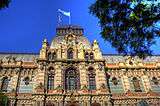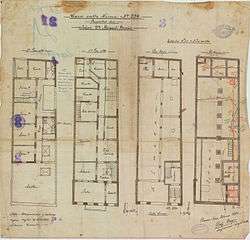The Water Company Palace

The Palace of Flowing Waters (Palacio de Aguas Corrientes) is an architecturally significant water pumping station in Buenos Aires, Argentina.
Overview
The building was designed as a water pumping station in 1877 by Swedish Argentine architect Carlos Nyströmer, and completed in 1894. It was commissioned, in part, to replace the unsightly water tower on Lorea Plaza (in what today is Congressional Plaza). Occupying a city block at the northern end of the city's Balvanera section, the Córdoba Avenue landmark still functions as a pumping station.[1] The French renaissance palace was covered in over 300,000 glazed, multi-color terra cotta tiles imported from the renowned British ceramics maker, Royal Doulton. It features a tin mansard roof, and is emblazoned with escutcheons representing the 14 Argentine provinces, at the time.[1]
The building's entrance is graced by two caryatids, and the property, by landscaped gardens that includea bust created by Norwegian sculptor Olaf Boye in honor of engineer Guillermo Villanueva, the first Director of the Buenos Aires Water Supply and Drainage Company Limited, the then British-owned municipal water works inaugurated in 1869.[2]
The building was transferred to the City of Buenos Aires following the 1892 nationalization of the British-owned company over service quality concerns. The company, eventually known as Obras Sanitarias (OSN), was reprivatized in 1993 with a 30-year contract. The contract's rescission in 2006 transferred the property to AySA, a State enterprise, however.[3] The palace still houses a number of water company offices, Historic Archives and a small water works museum.[1][4][5]
The building figures prominently in the book "Santa Evita" by Tomas Eloy Martinez.

Historic Archive
Established in 1873, this is the only Archive containing complete and specific information about emblematic buildings and water supply planning of Buenos Aires. [6] This archive is composed by three main Archives. [7]
Water Network Supply Archive
Contains plans about Water treatment plants, sewage and water network supply, drains and projects.
The information found in these plans includes type, size and material of pipes, dates, architectural drawings, etc.
Size of collection: about 60.000 plans, oldest is from 1870.
This archive is not available to the public. Some plans approved for public release were published through books, newspapers and websites. [8]
Water Connection Application Records
Holds a large collection of documents detailing building category, water connection application forms, construction materials, measures, number of pipe connections, names of the owners, etc of almost each building constructed in Buenos Aires.
Many documents are signed by famous and important people of Argentina such as president Bartolome Mitre, physiologist Bernardo Houssay, writer Jorge Luis Borges among others.
Size of collection: about 350,000 records.
This Archive is not available to the public. Some documents approved for public release were published through books, newspapers and websites.
Plumbing Plans Archive
Keeps plumbing and fire hydrants service plans of 320,000 land lots of Buenos Aires. These plans are crucial for finding water, drain and sewage connections and fixing water leaks. This Archive also preserves plans of buildings demolished during the construction of large avenues and highways of Buenos Aires, e.g. 9 de Julio Avenue.
Size of Collection: about 2,800,000 plans, oldest is from 1889.
This Archive is only available to proper authorized individuals. Some plans approved for public release were published through books, newspapers and websites.
Exterior

 Detail of the exterior facing Riobamba Street
Detail of the exterior facing Riobamba Street Detail of the main façade
Detail of the main façade
Interior
 Still pipes inside the facility
Still pipes inside the facility The building's museum
The building's museum- Former Water reservoir, now AySA Archives
- Historic AySA Archives
 Model of the Water Company Palace at AySA Archives
Model of the Water Company Palace at AySA Archives Historic Plumbing Plan at AySA Archives
Historic Plumbing Plan at AySA Archives
References
- 1 2 3 Wilson, Jason. A Cultural Guide to the City of Buenos Aires. Oxford, England: Signal Books, 1999.
- ↑ Obras Sanitarias, debut de la ingeniería Argentina (Spanish)
- ↑ Reseña histórica (Spanish)
- ↑ "Official AySA Website".
- ↑ "Historic Aysa Archives ordinance".
- ↑ "Historic Aysa Archives ordinance".
- ↑ "Historic Plans Archive brochure" (PDF).
- ↑ "Large Masonry Waste Vent".
External links
| Wikimedia Commons has media related to The Water Company Palace. |
- Museum of Water and Health History - Aguas y Saneamientos Argentinos (Spanish)
Coordinates: 34°36′02″S 58°23′42″W / 34.60056°S 58.39500°W